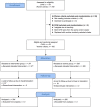Impact of smartphone-assisted prenatal home visits on women's use of facility delivery: Results from a cluster-randomized trial in rural Tanzania
- PMID: 29912954
- PMCID: PMC6005474
- DOI: 10.1371/journal.pone.0199400
Impact of smartphone-assisted prenatal home visits on women's use of facility delivery: Results from a cluster-randomized trial in rural Tanzania
Abstract
Background: About half of births in rural Tanzania are assisted by skilled providers. Point-of-care mobile phone applications hold promise in boosting job support for community health workers aiming to ensure safe motherhood through increased facility delivery awareness, access and uptake. We conducted a controlled comparison to evaluate a smartphone-based application designed to assist community health workers with data collection, education delivery, gestational danger sign identification, and referrals.
Methods: Community health workers in 32 randomly selected villages were cluster-randomized to training on either smartphone (intervention) or paper-based (control) protocols for use during household visits with pregnant women. The primary outcome measure was postnatal report of delivery location by 572 women randomly selected to participate in a survey conducted by home visit. A mixed-effects model was used to account for clustering of subjects and other measured factors influencing facility delivery.
Findings: The smartphone intervention was associated with significantly higher facility delivery: 74% of mothers in intervention areas delivered at or in transit to a health facility, versus 63% in control areas. The odds of facility delivery among women counseled by smartphone-assisted health workers were double the odds among women living in control villages (OR, 1.96; CI, 1.21-3.19; adjusted analyses). Women in intervention areas were more likely to receive two or more visits from a community health worker during pregnancy than women in the control group (72% vs. 60%; chi-square = 6.9; p < 0.01). Previous facility delivery, uptake of antenatal care, and distance to the nearest facility were also strong independent predictors of facility delivery.
Interpretation: Community health worker use of smartphones increased facility delivery, likely through increased frequency of prenatal home visits. Smartphone-based job aids may enhance community health worker support and effectiveness as one component of intervention packages targeting safe motherhood.
Trial registration: NCT03161184.
Conflict of interest statement
The authors have declared that no competing interests exist.
Figures



References
-
- Mahler H. The safe motherhood initiative: a call to action. Lancet. 1987;1(8534):668–70. . - PubMed
-
- Campbell OM, Graham WJ. Strategies for reducing maternal mortality: getting on with what works. Lancet. 2006;368(9543):1284–99. Epub 2006/10/10. doi: 10.1016/S0140-6736(06)69381-1 . - DOI - PubMed
-
- Fournier P, Dumont A, Tourigny C, Dunkley G, Dramé S. Improved access to comprehensive emergency obstetric care and its effect on institutional maternal mortality in rural Mali. Bulletin of the World Health Organization. 2009;87(1):30–8. doi: 10.2471/BLT.07.047076 PubMed PMID: PMC2649605. - DOI - PMC - PubMed
-
- Lawn JE, Cousens S, Zupan J. 4 million neonatal deaths: When? Where? Why? The Lancet. 365(9462):891–900. doi: 10.1016/S0140-6736(05)71048-5 - DOI - PubMed
-
- Say L, Chou D, Gemmill A, Tuncalp O, Moller AB, Daniels J, et al. Global causes of maternal death: a WHO systematic analysis. Lancet Glob Health. 2014;2(6):e323–33. doi: 10.1016/S2214-109X(14)70227-X . - DOI - PubMed
Publication types
MeSH terms
Associated data
Grants and funding
LinkOut - more resources
Full Text Sources
Other Literature Sources
Medical

